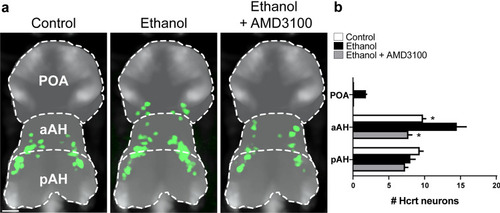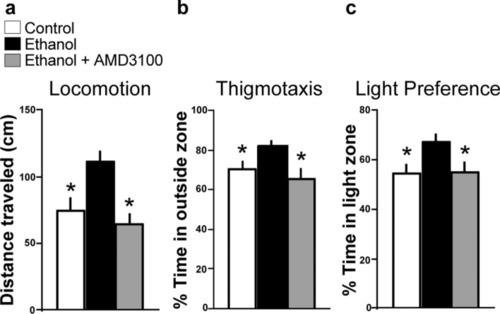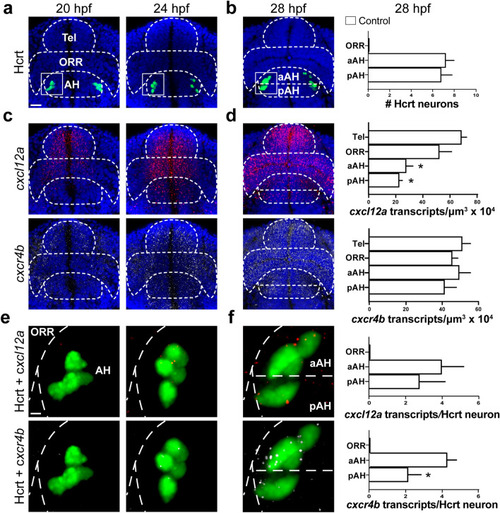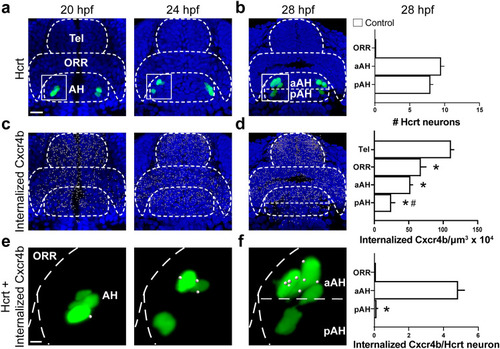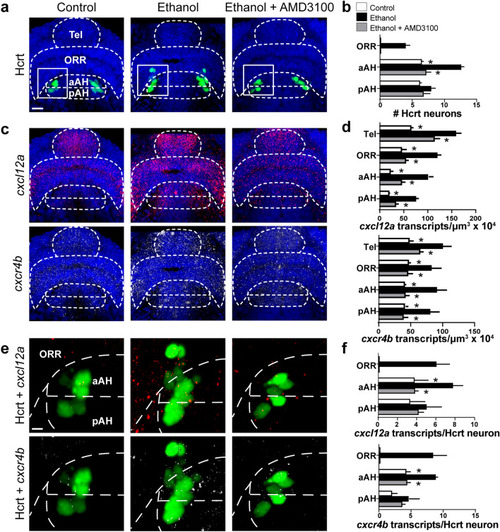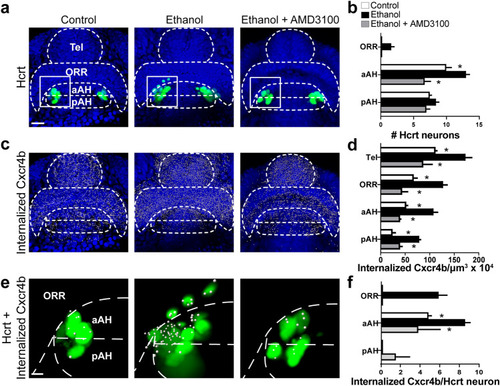- Title
-
Neuronal chemokine concentration gradients mediate effects of embryonic ethanol exposure on ectopic hypocretin/orexin neurons and behavior in zebrafish
- Authors
- Collier, A.D., Yasmin, N., Karatayev, O., Abdulai, A.R., Yu, B., Khalizova, N., Fam, M., Leibowitz, S.F.
- Source
- Full text @ Sci. Rep.
|
Photomicrographs illustrating the methodology used to quantify internalized Cxcr4b receptors colocalized within Hcrt neurons using immunofluorescence and also cxcl12a and cxcr4b transcripts colocalized within Hcrt neurons using RNAscope. (A) A representative confocal photomicrograph (×25) illustrates the 28 hpf zebrafish brain in a dorsal/ventral view with the aAH, pAH, ORR and Tel outlined by dashed lines. The Hcrt neurons (green) and internalized Cxcr4b receptors (white) are labeled using immunofluorescence, with counterstaining using DAPI (blue). (B) Enlargement of boxes at 28 hpf show the fluorescent signal (left) of the Hcrt neurons and internalized Cxcr4b receptors and the “Spots” labeling (right) of these internalized Cxcr4b receptors within Hcrt neurons using Imaris software for quantification. (C) Representative confocal photomicrographs (×25) show Hcrt neurons (green) with cxcl12a (top, red) and cxcr4b (bottom, white) transcripts labeled using RNAscope, with counterstaining using DAPI (blue). (D) Enlargement of boxes at 28 hpf show the fluorescent signal (left) of the Hcrt neurons and colocalized cxcl12a (top) and cxcr4b (bottom) transcripts and the Imaris “Spots” labeling (right) of these transcripts within Hcrt neurons using Imaris software for quantification. Scale bar low magnification 20 µm; high magnification 8 µm. aAH anterior part of the anterior hypothalamus, pAH posterior part of the anterior hypothalamus, ORR optic recess region, Tel telencephalon, Hcrt hypocretin, hpf hours post fertilization. |
|
Effects of exposure to embryonic ethanol (0.5% v/v, 22–24 hpf) and Cxcr4 antagonist AMD3100 (1 µM, 2–24 hpf) on the location of Hcrt neurons in the aAH, pAH and POA of 6 dpf zebrafish brains. (a) Photomicrographs (×25, overlay of n = 4 images in each condition) illustrate zebrafish brains, in a dorsal/ventral view obtained at 6 dpf using live-imaging, with pan-neuronal vglut2a expression (grey) and also Hcrt neurons (green) normally located in the aAH and pAH of control, ethanol, and ethanol + AMD3100 zebrafish and ectopically located in the POA of only ethanol zebrafish. (b) Bar graphs (n = 4/group) show that ethanol compared to control increases the number of Hcrt neurons in the aAH and induces ectopic neurons in the POA while having no effect in the pAH, and these effects on Hcrt neurons in the aAH and POA are totally blocked by AMD3100. Scale bar 20 µm. *p < 0.05 compared to ethanol. Results are shown as means ± standard errors. aAH anterior part of the anterior hypothalamus, pAH posterior part of the anterior hypothalamus, POA preoptic area, Hcrt hypocretin, hpf hours post fertilization, dpf days post fertilization. |
|
Effects of embryonic ethanol (0.5% v/v, 22–24 hpf) and Cxcr4 antagonist AMD3100 (1 µM, 2–24 hpf) on locomotor and anxiety-like behaviors in 8 dpf zebrafish. (a) Bar graphs (n = 29/group) show that ethanol compared to control increases locomotor activity, as indicated by an increase in distance traveled, and this ethanol effect is blocked by pretreatment with AMD3100. (b) Bar graphs (n = 29/group) show that ethanol increases anxiety-like behavior, indicated by an increase in perecentage of time spent in the perimeter of the arena (thigmotaxis), and this behavioral effect is blocked by AMD3100. (c) Bar graphs (n = 25/group) show that ethanol increases another anxiety-like behavior, indicated by an increase in percentage of time spent in the light half of the arena during the light–dark test (light preference), and this behavioral effect is blocked by AMD3100. *p < 0.05. Results are shown as means ± standard errors. hpf hours post fertilization, dpf days post fertilization. |
|
Embryonic development of Hcrt neurons and cxcl12a and cxcr4b transcripts under control conditions in 20, 24 and 28 hpf zebrafish brains, as evidenced by RNAscope. (a) Representative photomicrographs (×25) illustrate the zebrafish brain in a dorsal/ventral view with the AH, aAH, pAH, ORR and Tel of the brain outlined by dashed lines, the Hcrt neurons (green) tightly clustered together at 20 hpf while starting to spread out and increase in number at 24 hpf, and the cells counterstained with DAPI (blue). (b) Representative photomicrographs show Hcrt neurons (green) at 28 hpf that have migrated further anterior and become evenly distributed throughout the posterior (pAH) and anterior (aAH) parts of the AH, as shown in the bar graphs (n = 6). (c) Representative photomicrographs show the density of cxcl12a transcripts (red, top) and cxcr4b transcripts (white, bottom) naturally increases from 20 to 24 hpf, and the cxcl12a transcripts show a tendency to be highest in the anterior part of the brain, while the cxcr4b transcripts appear evenly distributed throughout all brain areas. (d) Representative photomicrographs show the cxcl12a transcripts (top) at 28 hpf as they become more dense and exhibit a natural posterior-to-anterior concentration gradient throughout the brain, with lowest levels in the pAH, moderate levels in the aAH and ORR, and highest levels in the Tel, as shown in the bar graph (n = 6). The density of cxcr4b transcripts (bottom), in contrast, is uniform across all brain regions, as shown in the bar graph (n = 6). (e) Enlargements of boxes at 20 hpf show no co-localization with cxcl12a (top) or cxcr4b (bottom) transcripts, while some co-localization is evident at 24 hpf. (f) Enlargement of boxes at 28 hpf show the cxcl12a and cxcr4b transcripts to exhibit high levels of co-localization with Hcrt neurons, with these colocalized transcripts showing dim expression. While the number of cxcl12a transcripts (top) are equally expressed in Hcrt neurons of the aAH and pAH, there is a significantly greater number of cxcr4b transcripts (bottom) in Hcrt neurons in the aAH compared to the pAH as shown in the bar graph (n = 6). Scale bar low magnification 20 µm; high magnification 8 µm. *p < 0.05 compared to Tel. Results are shown as means ± standard errors. AH anterior hypothalamus, aAH anterior part of the anterior hypothalamus, pAH posterior part of the anterior hypothalamus, ORR optic recess region, Tel telencephalon, Hcrt hypocretin, hpf hours post fertilization. |
|
Embryonic development of Hcrt neurons and internalized Cxcr4b under control conditions in 20, 24 and 28 hpf zebrafish brains, as evidenced by immunofluorescence histochemistry. (a) Representative photomicrographs (×25) illustrate the zebrafish brain in a dorsal/ventral view with the pAH, aAH, ORR and Tel of the brain outlined by dashed lines, the Hcrt neurons (green) shown tightly clustered together at 20 hpf while spreading out and increasing in number at 24 hpf, and the cells counterstained with DAPI (blue). (b) Hcrt neurons become more spread apart at 28 hpf, with an equal number of Hcrt neurons detected in the aAH and the pAH and no Hcrt neurons detected in the ORR, as shown in the bar graph (n = 4). (c) Representative photomicrographs show the density of internalized Cxcr4b receptors (white, indicated by digital “spots”) naturally increases from 20 to 24 hpf, and they show a tendency to increase from the AH to the Tel part of the brain. (d) Representative photomicrographs show the internalized Cxcr4b receptors at 28 hpf become more dense and exhibit a natural posterior-to-anterior concentration gradient throughout the brain, with lowest levels in the pAH, moderate levels in the aAH and ORR, and highest levels in the Tel, as shown in the bar graphs (n = 4). (e) Enlargements of boxes at 20 hpf show no Hcrt neurons with internalized Cxcr4b receptors, while internalized Cxcr4b receptors within Hcrt neurons become apparent at 24 hpf. (f) Enlargement of boxes at 28 hpf show an increase in the number of internalized Cxcr4b receptors in Hcrt neurons, with Hcrt neurons located in the aAH showing a greater number than the pAH of these internalized Cxcr4b receptors, as shown in the bar graphs (n = 4). Scale bar: low magnification 20 µm; high magnification 8 µm. *p < 0.05 and #p < 0.05 compared to Tel and aAH respectively. Results are shown as means ± standard errors. AH anterior hypothalamus, aAH anterior part of the anterior hypothalamus, pAH posterior part of the anterior hypothalamus, ORR optic recess region, Tel telencephalon, Hcrt hypocretin, hpf hours post fertilization. |
|
Effects of exposure to embryonic ethanol (0.5% v/v, 22–24 hpf) and administration of Cxcr4 antagonist AMD3100 (1 µM, 2–24 hpf) on the location of Hcrt neurons, density of cxcl12a and cxcr4b transcripts, and colocalization of cxcl12a and cxcr4b transcripts with Hcrt neurons in 28 hpf zebrafish brain. (a) Representative photomicrographs (×25) illustrate the zebrafish brain in a dorsal/ventral view with the pAH, aAH, ORR and Tel of the brain outlined by dashed lines and show that ethanol compared to control increases the number of Hcrt neurons (green) at 28 hpf only in the aAH and ectopically in the ORR, and these effects are completely blocked by AMD3100 as shown with cells counterstained with DAPI (blue). (b) Bar graphs (n = 4–5) show increased number of Hcrt neurons in the aAH of the ethanol group relative to the control and ethanol + AMD3100 groups, with no effect of ethanol on Hcrt number in the pAH. Ethanol-induced Hcrt neurons in the ORR are evident only in the ethanol group (c) Representative photomicrographs show the density of internalized cxcl12a (red, top) and cxcr4b (white, bottom) transcripts to be increased throughout the brain in the ethanol group compared to the control and ethanol + AMD3100 groups. (d) Bar graphs (n = 4–5) show increased density of the cxcl12a (top) and cxcr4b (bottom) transcripts in all brain regions, including the pAH, aAH, ORR and Tel, in the ethanol group compared to the control and ethanol + AMD3100 groups. (e) Enlargement of boxes at 28 hpf show the Hcrt neurons, located in the aAH and ectopically in the ORR but not the pAH, co-localize with a greater number of both cxcl12a (top) and cxcr4b (bottom) transcripts in the ethanol group compared to the control and ethanol + AMD3100 groups. (f) Bar graphs (n = 4–5) show an increased number of cxcl12a (top) and cxcr4b (bottom) transcripts in Hcrt neurons in the aAH of the ethanol group compared to the control and ethanol + AMD3100 groups, with no change between groups occurring in the pAH. Ectopically located Hcrt neurons in the ORR seen only in the ethanol group show similar levels of co-localization as evident in Hcrt neurons of the aAH. Scale bar low magnification 20 µm; high magnification 8 µm. *p < 0.05 compared to ethanol. Results are shown as means ± standard errors. AH anterior hypothalamus, aAH anterior part of the anterior hypothalamus, pAH posterior part of the anterior hypothalamus, ORR optic recess region, Tel Telencephalon, Hcrt Hypocretin, hpf hours post fertilization. |
|
Effects of exposure to embryonic ethanol (0.5% v/v, 22–24 hpf) and administration of Cxcr4 antagonist AMD3100 (1 µM, 2–24 hpf) on the location of Hcrt neurons, the density of internalized Cxcr4b receptors, and the colocalization of internalized Cxcr4b with Hcrt neurons in the 28 hpf zebrafish brain. (a) Representative photomicrographs (×25) illustrate the zebrafish brain in a dorsal/ventral view with the pAH, aAH, ORR and Tel of the brain outlined by dashed lines, and show that ethanol compared to control increases the number of Hcrt neurons (green) at 28 hpf, only in the aAH and ectopically in the ORR, and these effects are completely blocked by AMD3100 as shown with cells counterstained with DAPI (blue). (b) Bar graphs (n = 4–5) show increased number of Hcrt neurons in the aAH of the ethanol group relative to the control and ethanol + AMD3100 groups, with no change occurring between groups in the pAH, and ectopically located Hcrt neurons located in the ORR are evident only in the ethanol group. (c) Representative photomicrographs show the density of internalized Cxcr4b receptors (white, indicated by digital “spots”) to be increased throughout the brain in the ethanol group compared to the control and ethanol + AMD3100 groups. (d) Bar graphs (n = 4–5) show increased density of internalized Cxcr4b in all brain regions including the pAH, aAH, ORR and Tel in the ethanol group relative to the control and ethanol + AMD3100 groups. (e) Enlargement of boxes at 28 hpf show ethanol treatment to increase the number of internalized Cxcr4b receptors in Hcrt neurons compared to both control and ethanol + AMD3100 groups. (f) Bar graphs (n = 4–5) show increased number of internalized Cxcr4b in Hcrt neurons in the aAH of the ethanol group compared to the control and ethanol + AMD3100 groups, with no change occurring between groups in the pAH, and ectopically located Hcrt neurons in the ORR of the ethanol group show a similar number of internalized Cxcr4b in Hcrt neurons relative to those in the aAH. Scale bar low magnification 20 µm; high magnification 8 µm. *p < 0.05 compared to ethanol. Results are shown as means ± standard errors. AH anterior hypothalamus, aAH anterior part of the anterior hypothalamus, pAH posterior part of the anterior hypothalamus, ORR optic recess region, Tel Telencephalon, Hcrt Hypocretin, hpf hours post fertilization. |


